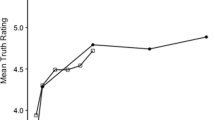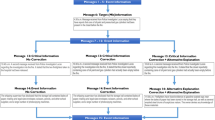Abstract
Absentmindedness is a special case of imperfect recall, in which a single history includes more than one decision node in an information set. Put differently, players, after making a decision, sometimes face it again without recalling having ‘been there before’. Piccione and Rubinstein (Game Econ Behav 20(1):3–24, 1997b) have argued that absentmindedness may lead to time inconsistencies. Specifically, in certain cases, a player’s optimal strategy as calculated when called to choose an action (the action stage) deviates from the optimal strategy as calculated in a preceding planning stage, although preferences remain constant and no new information is revealed between the two stages. An alternative approach assumes that the player maximizes expected payoff in the action stage while considering his actions at other decision nodes to be immutable. With this approach, no time inconsistencies arise. The present paper explores this issue from a behavioral point of view. We elicit participants’ strategies in an experimental game of absentmindedness, separately for a planning stage and an action stage. We find systematic and robust time inconsistencies under four variations of the experiment and using ten different parameterizations of the game. We conclude that real decisions under absentmindedness without commitment are susceptible to time inconsistencies.




Similar content being viewed by others
Notes
We speak of game (rather than decision) tree to stay in the framework of game theory.
To illustrate the difference between mixed and behavioral strategies in our game, compare the mixed and the behavioral strategy that both specify a probability of 0.5 to continue. The former implies that the same realized action is chosen at both \(X\) and \(Y\), resulting in an expected payoff of \(0.5a+0.5c\). With the latter, the actions chosen at \(X\) and \(Y\) are determined independently, resulting in an expected payoff of \(0.5a+0.25b+0.25c\).
Theoretical discussions of the paradoxes arising under absentmindedness can be found in Battigalli (1997), Gilboa (1997), Grove and Halpern (1997), Halpern (1997), Aumann et al. (1997b), and Lipman (1997), which are summarized and countered in Piccione and Rubinstein (1997a), Binmore (1996), Kline (2005) and Board (2003). The question of beliefs under absentmindedness spawned a prolific literature in philosophy starting with Elga (2000).
Methodologically, the experiment can be taken as a test of the game-theoretical predictions. As such, our goal was to construct a laboratory situation which is in the base domain of the theory. Consequently, the universal nature of game theory places the experiment firmly within the test domain of the theory (Bardsley et al. 2010).
We will discuss the details of their design in Sect. 3.
For example, presenting the decision as one of whether to exit to the right may create a bias to exit (cf. Wilson and Nisbett 1978).
For example, with payoffs (\(a\), \(b\), \(c\)) = (1, 5, 2), the optimal mixed strategy is to continue with probability 1 for a payoff of 2, whereas the optimal behavioral strategy is to continue with probability \(\frac{2}{3}\) for a payoff of \(2\frac{1}{3}\). Note that implementing the planning-optimal behavioral strategy as a mixed strategy yields a sub-optimal payoff of \(1\frac{2}{3}\).
When people must process large amounts of information within a short time span, the limited capacity of their short-term memory causes cognitive overload (see, e.g., Kareev and Warglien 2003). Short-term memory capacity refers to the number of items that an individual can retain at one time and is classically estimated to be \(7\pm 2\) (Miller 1956; Shiffrin 1976; Kareev 2000); but see Cowan (2001), for a lower estimate.
Recall that eliciting pure actions in this stage, as done by Deck and Sarangi (2009), effectively implements mixed rather than behavioral strategies.
One is that it gives rise to a game of absentmindedness with six decision nodes in the information set: three corresponding to the ones in Fig. 2 and three for the reverse-order game. Another is that the game form is the same as in Fig. 2, with the final payoffs being the expected payoffs over the two orders. While the planning-optimal strategy remains the same in all interpretations, the action-optimal strategy can vary substantially. In particular, the paradox does not necessarily hold for some (inconsistent) beliefs.
Our data confirm that participants in the IMP treatment did not follow this strategy, which would drive the mean probability assigned to “continue” in the action stage towards 0.5.
The numbers in Table 1 are chosen so that the expected payoff from option \(A\) exceeds the expected payoff from the other two options whenever the probability assigned to being correct is lower than \(2/3\). Only if the probability of being correct is greater than \(5/6\), a risk neutral decision maker should opt for \(C\). In principle, the belief elicitation procedure gives participants an opportunity to diversify since they can play according to their true beliefs and state the opposite beliefs. Our results, however, show that participants actually play in line with their stated beliefs.
By paying a small monetary amount over a large number of periods we try to induce risk neutrality.
As the planning-stage treatment is identical for all participants and the participants are unaware of the following action stage, we pool the planning-stage data. We average choices for each participant over the four instances of each tree (defined by background colors) to increase reliability.
This turns the game into a game with imperfect recall, but not absentmindedness.
The connecting lines in Fig. 3 were added to visually emphasize this fact.
Note that diversification in order to reduce risk implies the opposite.
These patterns can be rationalized as risk-seeking behavior. We find this explanation to be implausible.
References
Abreu D, Rubinstein A (1988) The structure of Nash equilibrium in repeated games with finite automata. Econometrica 56(6):1259–1281
Aumann R, Hart S, Perry M (1997a) The absent-minded driver. Game Econ Behav 20:102–116
Aumann R, Hart S, Perry M (1997b) The forgetful passenger. Game Econ Behav 20(1):117–120
Bardsley N, Cubitt R, Loomes G, Moffatt P, Starmer C, Sugden R (2010) Experimental economics: rethinking the rules. Princeton University Press, Princeton
Battigalli P (1997) Dynamic consistency and imperfect recall. Game Econ Behav 20(1):31–50
Binmore K (1996) A note on imperfect recall. In: Albers W, Güth W, Hammerstein P, Moldovanu B, Van Damme E (eds) Understanding strategic interaction—essays in honor of Reinhard Selten. Springer, Berlin, pp 51–62
Board O (2003) The not-so-absent-minded driver. Res Econ 57(3):189–200
Cowan N (2001) The magical number 4 in short-term memory: a reconsideration of mental storage capacity. Behav Brain Sci 24(1):87–114
Deck C, Sarangi S (2009) Inducing imperfect recall in the lab. J Econ Behav Organ 69:64–74
Deese J, Kaufman RA (1957) Serial effects in recall of unorganized and sequentially organized verbal material. J Exp Psychol 54(3):180–187
Elga A (2000) Self-locating belief and the sleeping beauty problem. Analysis 60(266):143–147
Epstein LG, Schmeidler D (2003) Recursive multiple-priors. J Econ Theory 113:1–31
Fischbacher U (2007) z-tree: Zurich toolbox for ready-made economic experiments. Exp Econ 10(2): 171–178
Gilboa I (1997) A comment on the absent-minded driver paradox. Game Econ Behav 20(1):25–30
Gilboa I, Schmeidler D (1989) Maxmin expected utility with nonunique prior. J Math Econ 18:141–153
Greiner B (2004) An online recruitment system for economic experiments. In: Kremer K, Macho V (eds) Forschung und wissenschaftliches Rechnen 2003. GWDG Bericht 63, Gesellschaft für Wissenschaftliche Datenverarbeitung, Göttingen, pp 79–93
Grove AJ, Halpern JY (1997) On the expected value of games with absentmindedness. Game Econ Behav 20(1):51–65
Halpern JY (1997) On ambiguities in the interpretation of game trees. Game Econ Behav 20(1):66–96
Hitchcock C (2004) Beauty and the bets. Synthese 139(3):405–420
Huck S, Müller W (2002) Absent-minded drivers in the lab: testing Gilboa’s model. Int Game Theory Rev 4(4):435–448
Isbell J (1957) Finitary games. In: Contributions to the theory of games III. Princeton University Press, Princeton, pp 79–96
Kahneman D (1973) Attention and effort. Prentice Hall, Englewood Cliffs
Kahneman D (2011) Thinking: fast and slow. Farrar Straus and Giroux, New York
Kahneman D, Tversky A (1979) Prospect theory: analysis of decision under risk. Econometrica 47(2): 263–292
Kareev Y (2000) Seven (indeed, plus or minus two) and the detection of correlations. Psychol Rev 107(2):397–402
Kareev Y, Warglien M (2003) Cognitive overload and the evaluation of risky alternatives: the effects of sample size, information format and attitude to risk. Discussion Paper 340, Center for the Study of Rationality
Kline J (2005) Imperfect recall and the relationships between solution concepts in extensive games. Econ Theory 25(3):703–710
Kuhn HW (1953) Extensive games and the problem of information. In: Contributions to the theory of games II. Princeton University Press, Princeton, pp 193–216
Lehrer E (1988) Repeated games with stationary bounded recall strategies. J Econ Theory 46(1):130–144
Lipman BL (1997) More absentmindedness. Game Econ Behav 20(1):97–101
Miller GA (1956) The magic number 7, plus or minus 2: some limits on our capacity for processing information. Psychol Rev 63:81–97
Murdock BB Jr (1962) The serial position effect of free recall. J Exp Psychol 64(5):482–488
Piccione M, Rubinstein A (1997a) The absent-minded driver’s paradox: synthesis and responses. Game Econ Behav 20(1):121–130
Piccione M, Rubinstein A (1997b) On the interpretation of decision problems with imperfect recall. Game Econ Behav 20(1):3–24
Rubinstein A (1986) Finite automata play the repeated prisoner’s dilemma. J Econ Theory 39(1):83–96
Shiffrin RM (1976) Capacity limitations in information processing, attention, and memory. In: Estes WK (ed) Handbook of learning and cognitive processes, vol 4. Erlbaum, Hillsdale, pp 177–236
Wilson TD, Nisbett RE (1978) The accuracy of verbal reports about the effects of stimuli on evaluations and behavior. Soc Psychol 41:118–131
Acknowledgments
Financial support from the Max Planck Society is gratefully acknowledged. We thank the members and students of the Center for the Study of Rationality in Jerusalem and the Max Planck Institute of Economics in Jena, and particularly Bob Aumann, Ido Erev, Werner Güth, Joe Halpern, Sergiu Hart, Yaakov Kareev, Dave Lagnado, Motty Perry, Michele Piccione, Ariel Rubinstein, Larry Samuelson, Sudipta Sarangi, Ran Shorrer, and Shmuel Zamir for helpful discussions and comments. We thank Christoph Göring for assistance with programming.
Author information
Authors and Affiliations
Corresponding author
Electronic supplementary material
Below is the link to the electronic supplementary material.
Rights and permissions
About this article
Cite this article
Levati, M.V., Uhl, M. & Zultan, R. Imperfect recall and time inconsistencies: an experimental test of the absentminded driver “paradox”. Int J Game Theory 43, 65–88 (2014). https://doi.org/10.1007/s00182-013-0373-y
Accepted:
Published:
Issue Date:
DOI: https://doi.org/10.1007/s00182-013-0373-y




